Grauman's Chinese Theatre
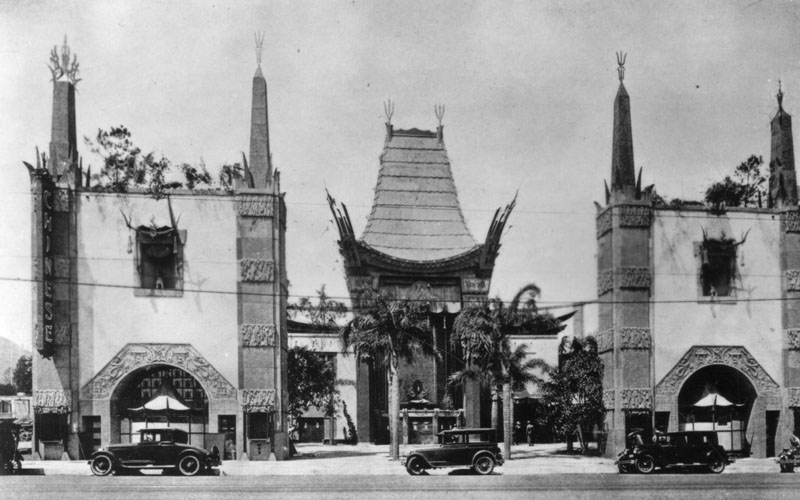 |
|
| (1927)* - View showing Grauman's Chinese Theatre on Hollywood Boulevard shortly after it opened. |
Historical Notes Grauman's Chinese Theatre opened in May 18, 1927, after a construction period of 18 months. Built to resemble a giant, red Chinese pagoda, the architecture features a huge Chinese dragon across the front, two stone lion-dogs guarding the main entrance, and the silhouettes of tiny dragons up and down the sides of the copper roof. |
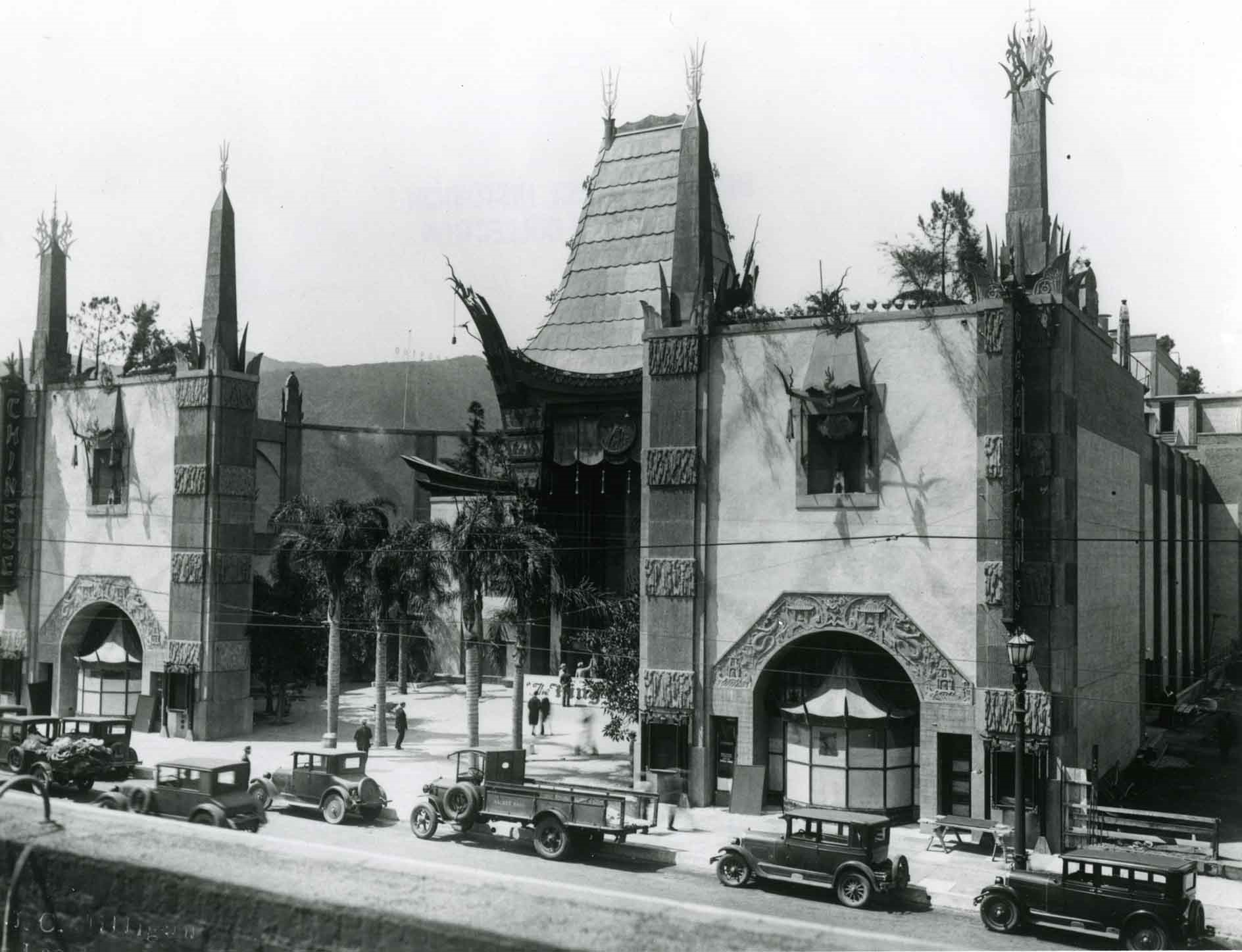 |
|
| (1927)* - View of Grauman's Chinese Theatre the year it opened, with its one-of-a-kind grandeur and décor. |
Historical Notes The theatre rises 90-feet high and two gigantic coral red columns topped by wrought iron masks hold aloft the bronze roof. Between the columns is a 30-foot high dragon carved from stone. Guarding the theatre entrance to this day are the two original giant Heaven Dogs brought from China. The large gong, above the entrance, near the roof, would ring just before the movie would start. |
 |
|
| (1927)* – Close-up view of the entrance to Grauman’s Chinese Theatre shortly after its construction. Notice there are no footprints except near the curb. Although several accounts exist regarding how the tradition began, the most widely accepted story involves silent film star Norma Talmadge accidentally stepping into wet cement while visiting her friend Sid Grauman. Inspired by this imprint, Grauman saw an opportunity to create a unique promotional feature for his theater. He invited his friends and business partners, Douglas Fairbanks and Mary Pickford, to intentionally leave their handprints and footprints in the wet cement—and the rest is history. |
Historical Notes The tradition of celebrity footprints and handprints in front of the Chinese Theatre in Hollywood began in 1927, shortly after the theater's construction. While there are several accounts of how it started, the most widely accepted story involves silent film star Norma Talmadge accidentally stepping into wet cement while visiting her friend Sid Grauman at his newly built theater. Inspired by this accidental imprint, Grauman saw an opportunity to create a unique promotional feature for his theater. He invited his friends and business partners, Douglas Fairbanks and Mary Pickford, to intentionally leave their hand and footprints in the wet cement. Grauman himself also added his prints, creating the first set of celebrity imprints in what would become known as the "Forecourt of the Stars." Alternative accounts exist, including one where Grauman claimed he accidentally stepped in wet concrete himself, giving him the idea. Another version suggests that the original "accidental" slabs were initially made at the curb on the sidewalk and remained there until 1958 when they were removed to make way for the Hollywood Walk of Fame. |
 |
|
| (1927)* - Night view shows theater lights and throngs of fans packing the streets for blocks around Grauman's Chinese Theatre. Publicity of Hollywood premiers usually brought stars and other distinguished visitors to magnificent events such as the one seen here - possibly the opening night of a movie starring Douglas Fairbanks. |
Historical Notes After his success with the Egyptian Theatre, Sid Grauman turned to Charles E. Toberman to secure a long term lease on property at 6925 Hollywood Blvd. Toberman contracted the architectural firm of Meyer & Holler (who had also designed the Egyptian) to design a "palace type theatre" of Chinese design. Grauman's Chinese Theatre was financed by Grauman, who owned a one-third interest, and his partners: Mary Pickford, Douglas Fairbanks, and Howard Schenck. The principal architect of the Chinese Theatre was Raymond M. Kennedy, of Meyer and Holler. |
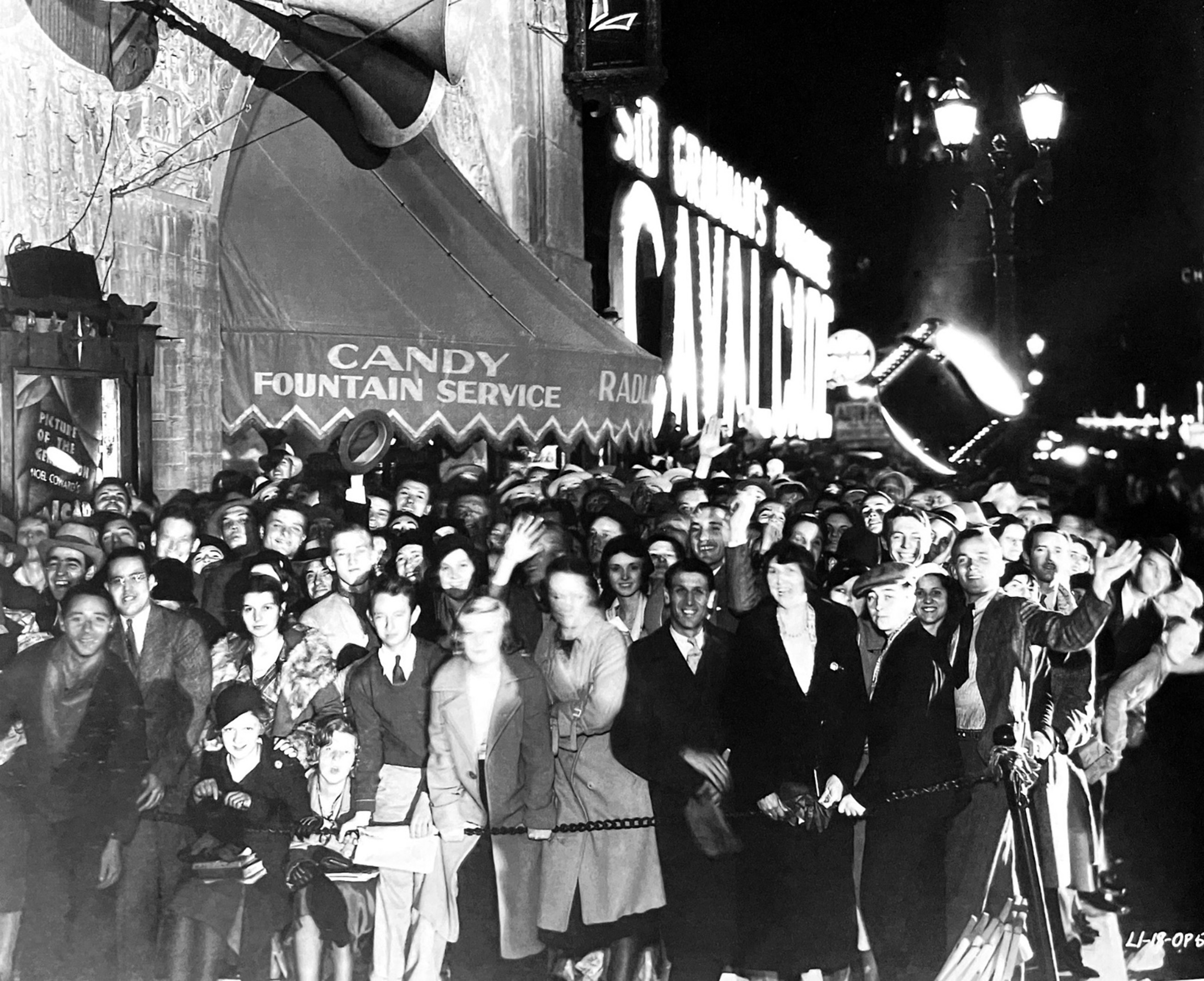 |
|
| (1933)* - Crowd at premiere of Fox Film's "Cavalcade", Grauman's Chinese Theater, Hollywood, CA, 1/12/1933. |
Historical Notes Cavalcade is a 1933 American epic pre-Code drama film directed by Frank Lloyd. The screenplay by Reginald Berkeley and Sonya Levien is based on the 1931 play of the same title by Noël Coward. The film stars Diana Wynyard and Clive Brook. |
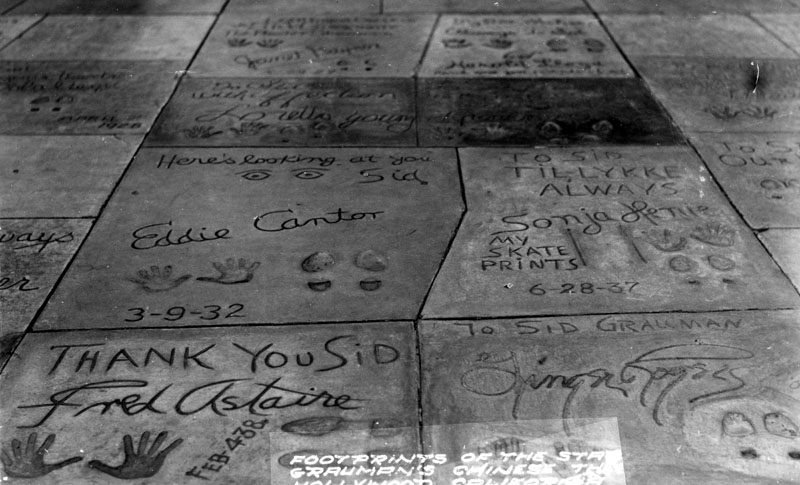 |
|
| (ca. 1930s)* - Footprints of the stars at Grauman's Chinese Theater in Hollywood. |
Historical Notes During construction, Grauman hired Jean Klossner to formulate an extremely hard concrete for the forecourt of the theatre. Klossner later became known as "Mr. Footprint," performing the footprint ceremonies from 1927 through 1957. |
 |
|
| (1927)* - View of Douglas Fairbanks putting his shoe print in the fresh concrete in front of the Grauman's Chinese Theater. Mary Pickford is by his side. |
Historical Notes Douglas Fairbanks and Mary Pickford were the inaugural celebrities to put their feet and handprints into fresh concrete at Grauman's Chinese Theater on April 30, 1927. This picture shows the two stars, exhibitor Sid Grauman, a workman, and how the event was apparently not open to the public. |
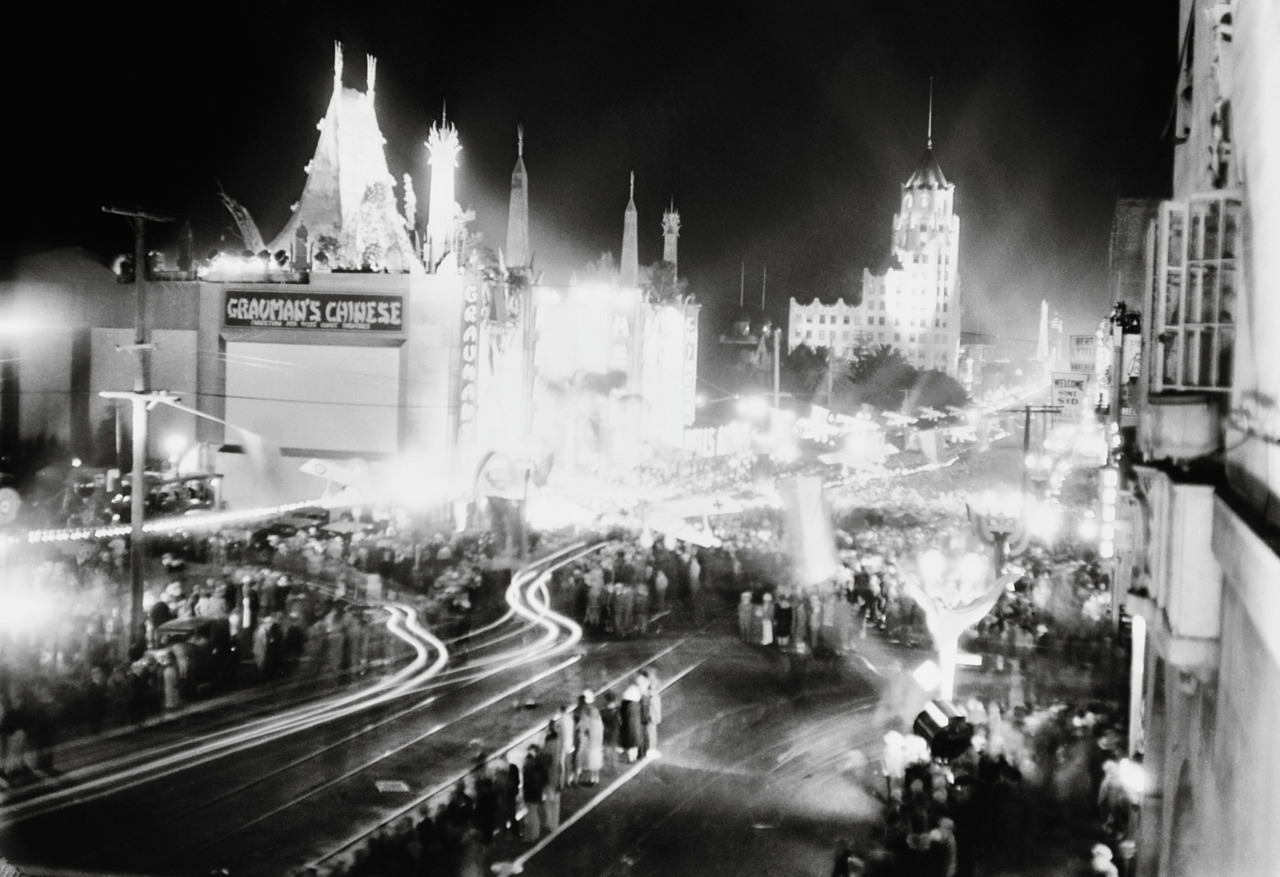 |
|
| (1930)* - The premiere of “Hell’s Angels” at Grauman’s Chinese Theatre in Hollywood as seen from the Roosevelt Hotel across the street. |
Historical Notes Hell's Angels is a 1930 American war film, directed by Howard Hughes and starring Jean Harlow, Ben Lyon, and James Hall. The film, which was produced by Hughes and written by Harry Behn and Howard Estabrook, centers on the combat pilots of World War I. Originally shot as a silent film, Hughes retooled the film over a lengthy gestation period. Most of the film is in black and white, but there is one color sequence - the only color footage of Harlow's career. Hell's Angels is now hailed as one of the first sound blockbuster action films. |
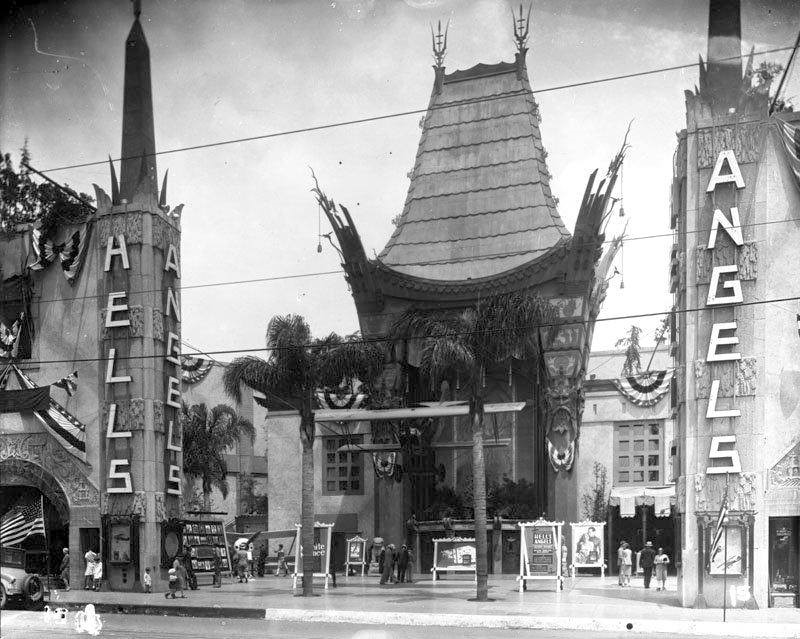 |
|
| (1930)* - Street view of the Grauman's Chinese Theatre where the film "Hell's Angels" is playing. |
Historical Notes Producer/director Howard Hughes poured nearly $4 million into his production of “Hell’s Angels” so he wanted to make sure everybody knew about it. On May 24, 1930 he threw a premiere the likes of which Hollywood had never seen before. And for the movie’s run at Grauman's Chinese Theatre, he had the title emblazoned on the columns, just in case, you know, there was anyone left who hadn’t heard of his movie. |
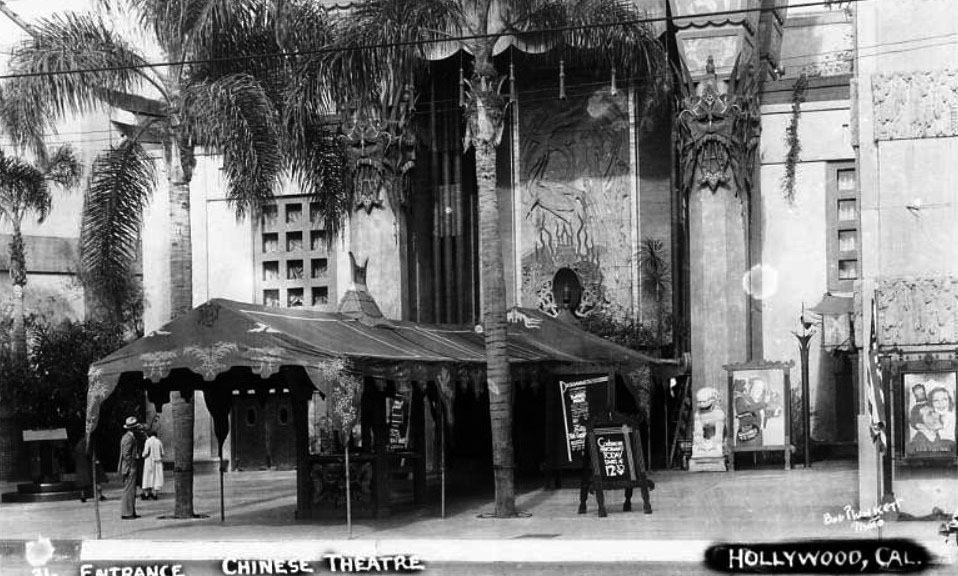 |
|
| (1934)* – Close-up postcard view showng the entrance to the Chinese Theatre with the box office installed in the forecourt. Now Playing: "The White Parade" with Loretta Young and John Boles |
Historical Notes Between 1933 and 1949 the Grauman's Chinese Theatre was in a "Golden Age," where the movies were the number-one entertainment in America, resulting in the studios who made them becoming very profitable. Grauman's Chinese, the glamourous flagship venue of the Fox West Coast Theatres chain (itself owned by 20th Century-Fox and the Skouras Brothers) and under the continuing management of Sid Grauman, played host to a large number of Fox films, rotating with product from Metro-Goldwyn-Mayer and the occasional offering from United Artists. Theatres during this time tended to play pictures from the studio who owned them (or had strong business ties to). |
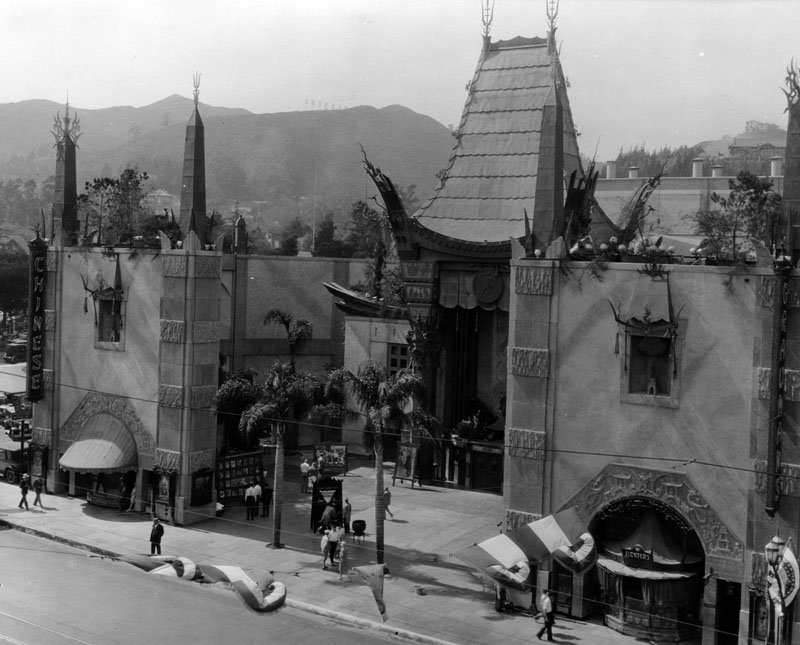 |
|
| (ca. 1940s)* - View of Grauman's Chinese Theatre, located at 6925 Hollywood Blvd., as seen from across the street. It is one of Hollywood's most beautiful theaters. |
Historical Notes All remained well until, after World War II, film attendance dropped off, then another blow: television. However, in the long run Hollywood found ways of making motion picture entertainment more attractive. People would once again return to the box office and pay admissions to see motion pictures instead of remaining home before their television sets. |
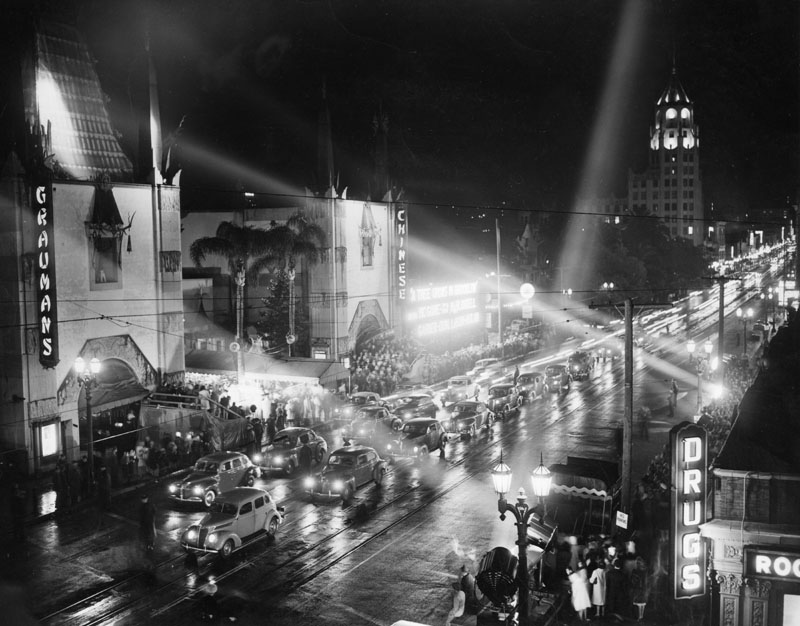 |
|
| (1944)* – View of the Grauman's Chinese Theatre just prior to the 16th Annual Academy Awards of Merit ceremony, Thursday, March 2, 1944. |
Historical Notes Originally handed out at a formal banquet at either the Ambassador Hotel in the Cocoanut Grove or Fiesta Room, or at the Biltmore Hotel downtown, in the Sala D'Oro or Biltmore Bowl, the enormity of interest in the Oscars outgrew the formal banquet idea. When it came time to hold the ceremony in a regular theatre environment, Grauman's Chinese was the obvious choice. Widely considered Hollywood's "town hall," for the first ceremony held there on Thursday, March 2, 1944, the theatre was donated for the event by Charles Skouras, president of National Theatres, whose Fox West Coast Theatres division operated the Chinese, with Sid Grauman as the theatre's Managing Director. |
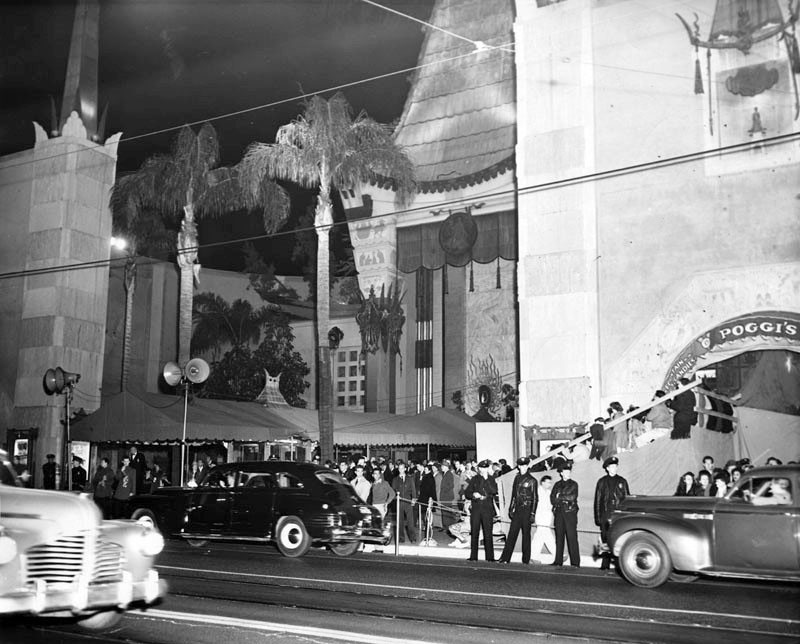 |
|
| (1946)* - Stars arrive at Grauman's Chinese Theater for the Academy Awards presentation on March 8, 1946. |
Historical Notes This was the year that “Lost Weekend” won Best Picture, Best Director, Best Actor in a Leading Role, and Best Screenplay. If these people were hoping to see Joan Crawford, they were disappointed. She was so freaked out at the thought of losing that she pretended to be ill—and then won the Oscar for “Mildred Pierce.” |
.jpg) |
|
| (1946)* – Thousands of movie fans crowded the front of Grauman's Chinese Theater in which the Academy Awards presentation was held. This is a section of the huge crowd as they watched the parade of stars arriving at the theater on March 8, 1946. |
Historical Notes National Theatres continued to make the Chinese Theatre available to the Academy for their Awards of Merit program at no cost, in 1944, 1945 and 1946. In short time the ceremony had outgrown even Sid's Hollywood masterwork, so it moved to the 6,000 plus-seat Shrine Auditorium near downtown for 1947 and 1948. |
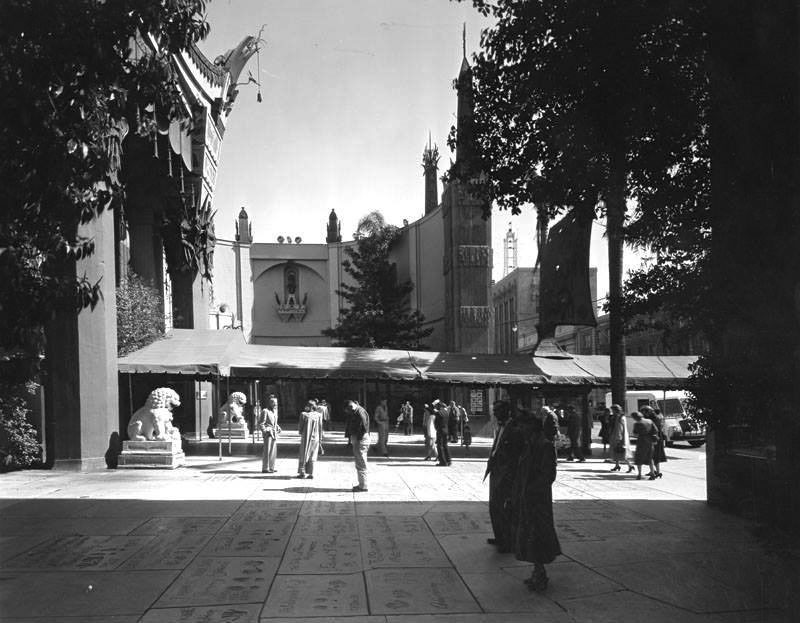 |
|
| (1950s)* – View showing the forecourt of Grauman’s Chinese Theatre where visitors are trying to find the footprints of their favorite star and marvel at how small their handprints were. Guarding the theatre entrance to this day are the two original giant Heaven Dogs brought from China. |
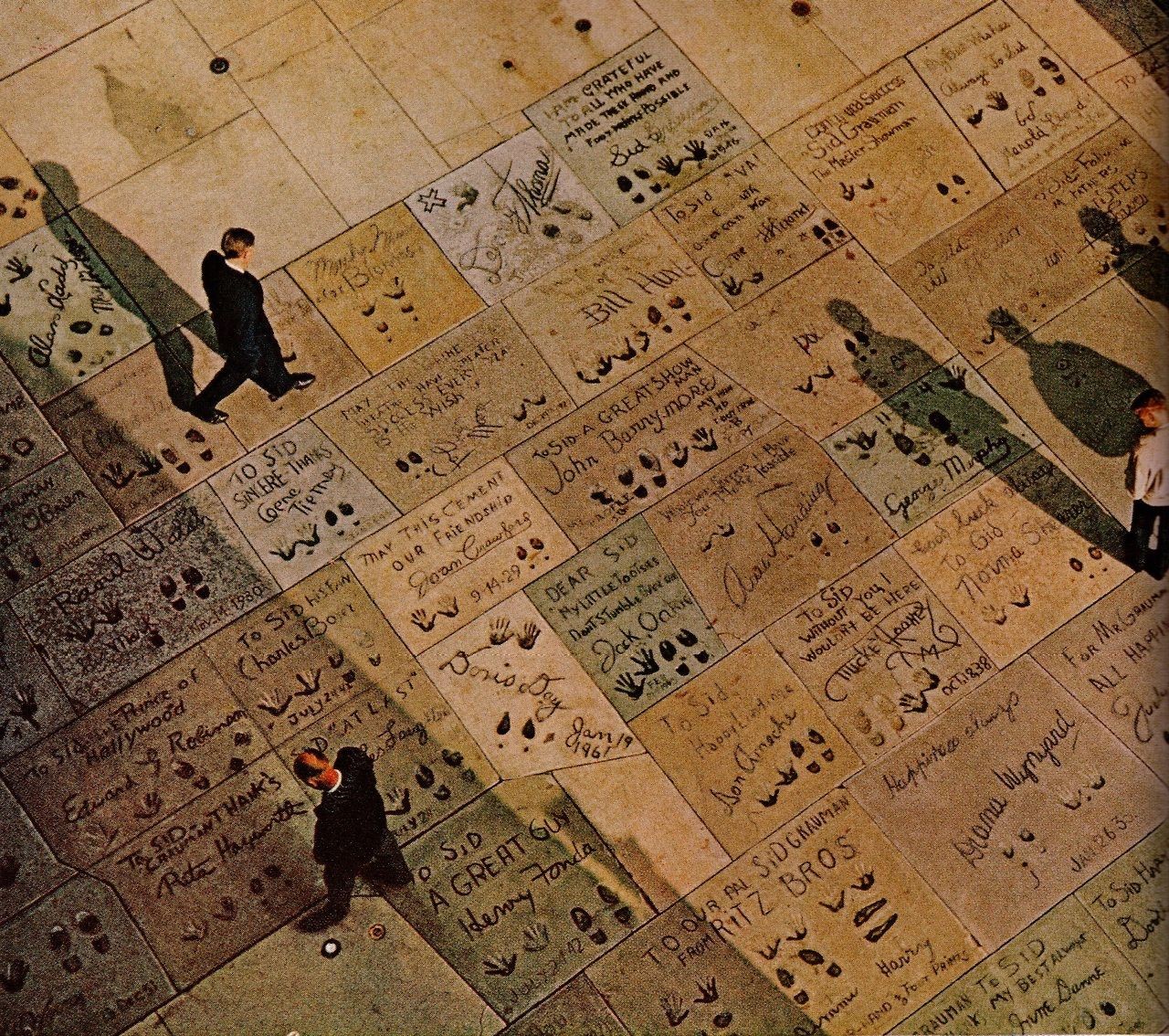 |
|
| (1962)* – Tourists admire the preserved footprints, handprints, and signatures of past movie stars on the concrete forecourt of Grauman’s Chinese Theatre. Photo Source: National Geographic. |
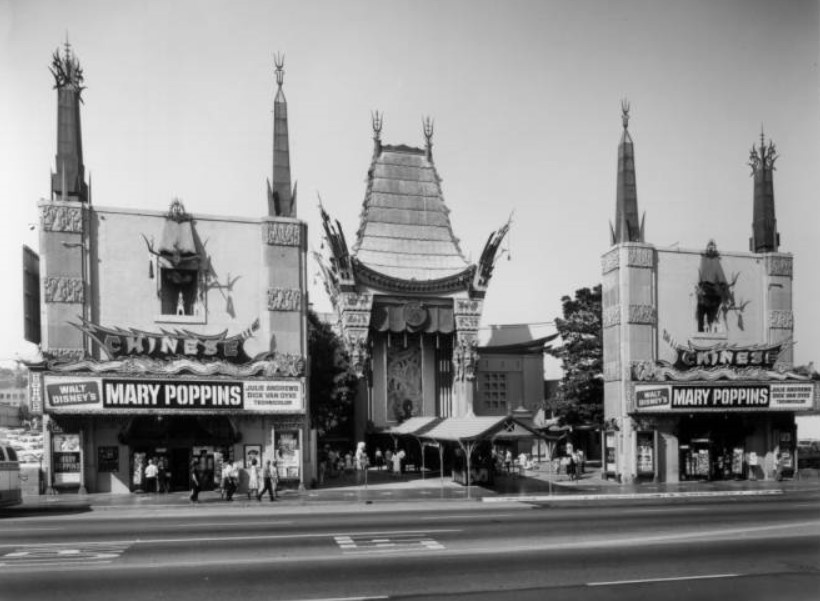 |
|
| (1964)* - View of the Grauman's Chinese Theatre (now TLC Chinese Theatre) on Hollywood Boulevard, showing Walt Disney's Mary Poppins. |
Historical Notes Mary Poppins was released on August 27, 1964, to critical acclaim and commercial success. It became the highest-grossing film of 1964 and, at the time of its release, was Disney's highest-grossing film ever. It received a total of 13 Academy Awards nominations, including Best Picture – a record for any film released by Walt Disney Studios – and won five: Best Actress for Andrews, Best Film Editing, Best Original Music Score, Best Visual Effects, and Best Original Song for "Chim Chim Cher-ee". In 2013, the film was selected for preservation in the United States National Film Registry by the Library of Congress as being "culturally, historically, or aesthetically significant". Mary Poppins is considered Walt Disney's crowning live-action achievement, and is the only one of his films which earned a Best Picture nomination during his lifetime. |
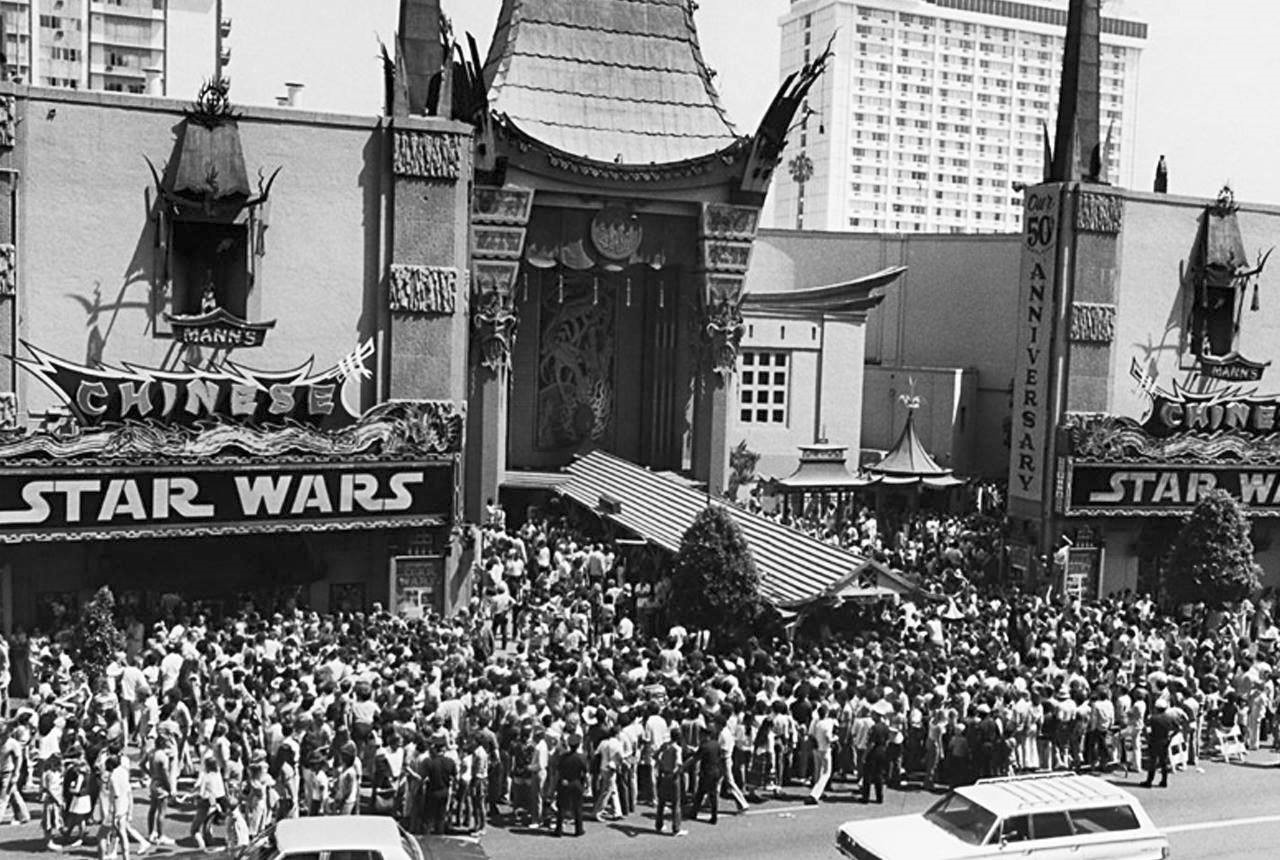 |
|
| (1977)* – Crowds gather in front of Grauman’s Chinese Theatre to get a glimpse of their favorite stars at the Star Wars preview. LA Times Archive |
Historical Notes Star Wars is an American epic space opera media franchise created by George Lucas, which began with the eponymous 1977 film and quickly became a worldwide pop-culture phenomenon. The franchise has been expanded into various films and other media, including television series, video games, novels, comic books, theme park attractions, and themed areas, comprising an all-encompassing fictional universe. The franchise holds a Guinness World Records title for the "Most successful film merchandising franchise." In 2020, the Star Wars franchise's total value was estimated at US$70 billion, and it is currently the fifth-highest-grossing media franchise of all time. |
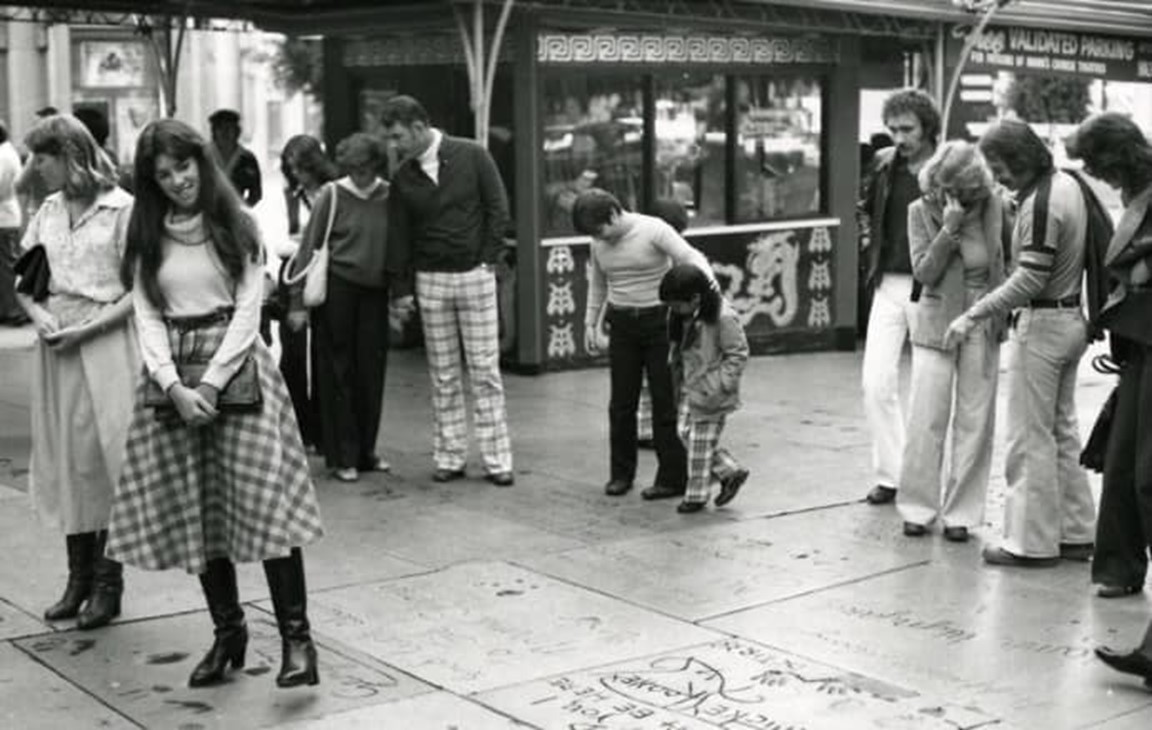 |
|
| (1985)* - Tourists looking at the hands and footprint impressions in the courtyard of the Chinese Theatre in Hollywood. |
Historical Notes While many of the late 20th and early 21st century imprints bear only the owners’ signatures, a number of the older slabs feature messages to “Sid” (Grauman). |
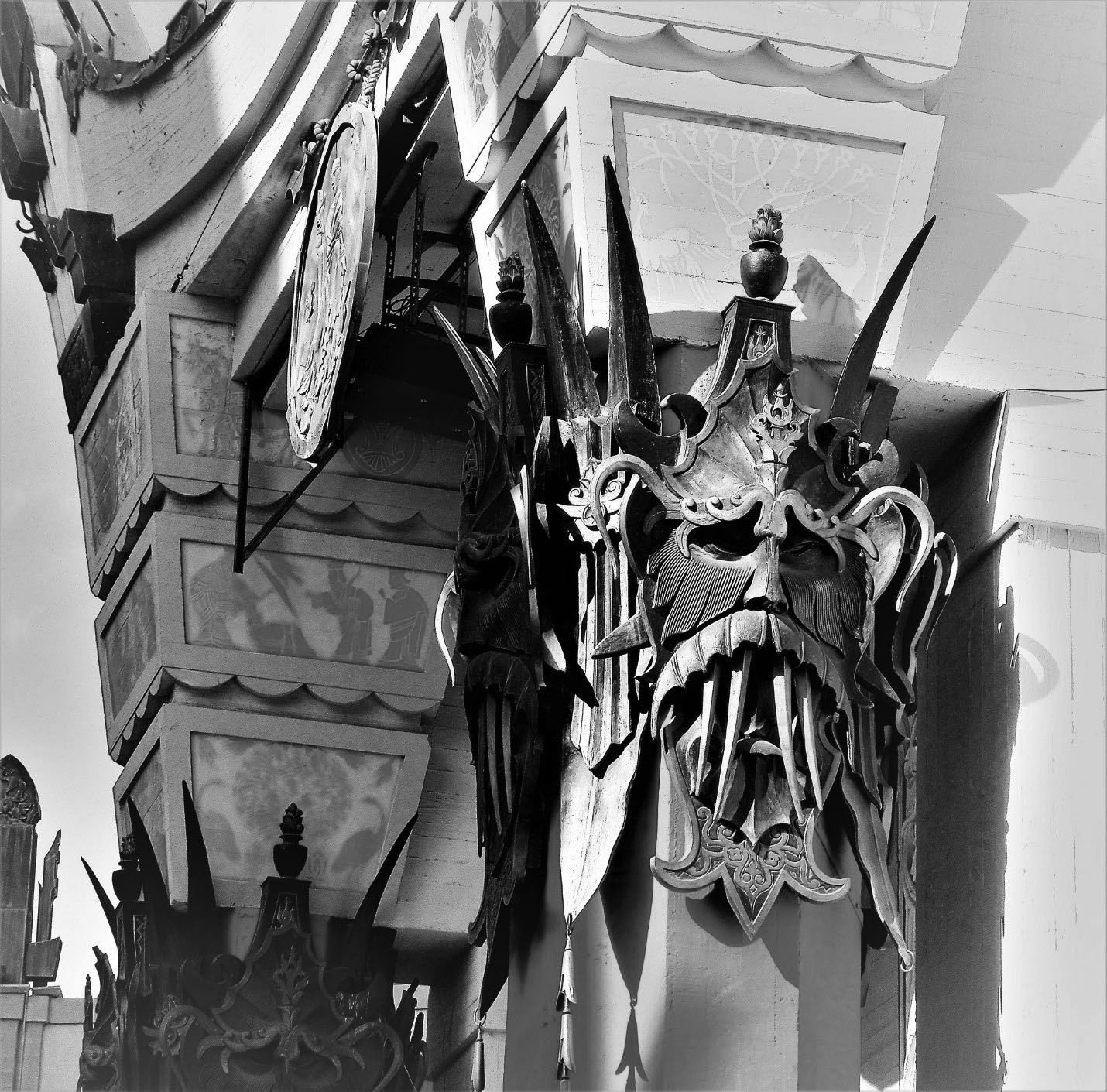 |
|
| (2020)* - Exterior detail view of TCL Chinese Theatre after renovation. Photo by Howard Gray |
Historical Notes The theatre underwent a $7 million renovation in 2000-01 that upgraded amenities, uncovered long-obscured details, and restored the exterior to its original appearance. Now known as TCL Chinese Theatre, the building underwent another renovation in 2013 to provide first-run IMAX capabilities. |
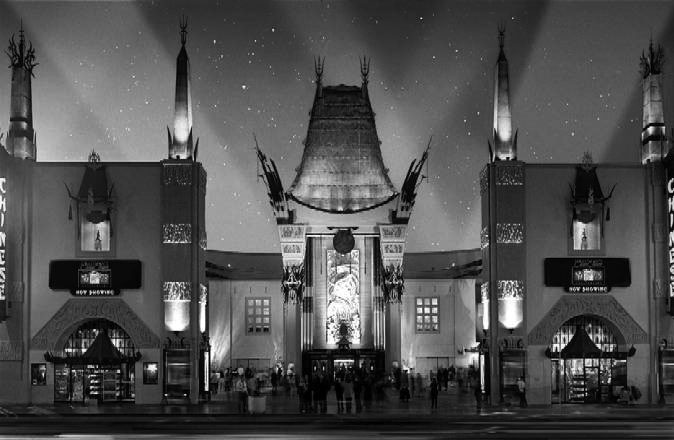 |
|
| (2014)* - Front view of the TCL Chinese Theatre on Hollywood Boulevard as it appears today. Photo by David McNew / CBS |
Historical Notes In 1968, Grauman's Chinese Theatre was dedicated LA Historic-Cultural Monument No. 55 (Click HERE to see complete listing). In 2013, the world famous Chinese Theatre teamed up with one of China’s biggest electronics manufacturers, TCL, aka “The Creative Life” in a 10-year naming rights partnership. |
Then and Now
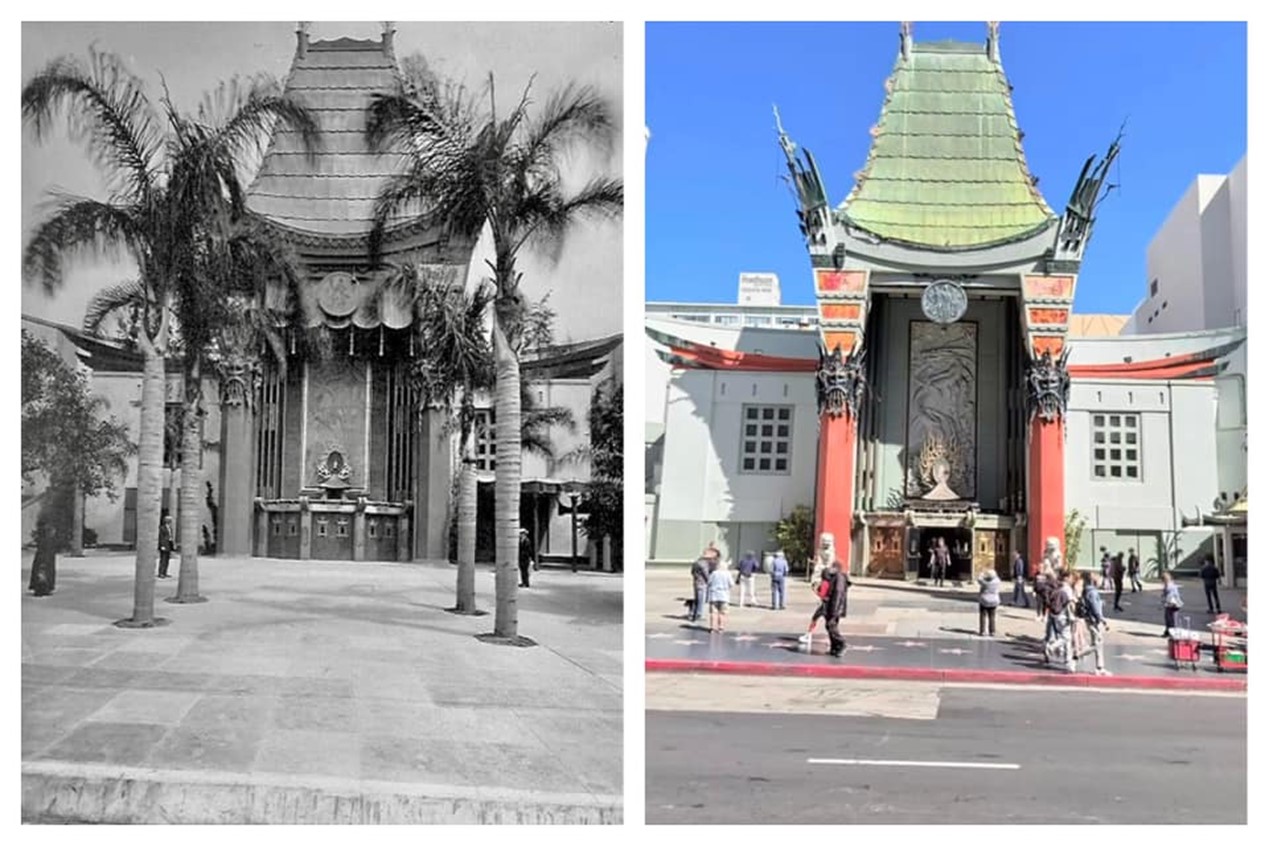 |
|
| (1927 vs 2024)* - Then and Now - Photo comparison by Trey Callaway |
Then and Now
 |
|
| Then and Now - Over 95 years old and well preserved. |
* * * * * |
|
Other Sections of Interest |
|
Water and Power in Early LA |
|
Newest Additions |
New Search Index |

A new SEARCH INDEX has been added to help navigate through the thousands of topics and images found in our collection. Try it out for a test run.
Click HERE for Search Index |
* * * * * |
< Back
Menu
- Home
- Mission
- Museum
- Major Efforts
- Recent Newsletters
- Historical Op Ed Pieces
- Board Officers and Directors
- Mulholland/McCarthy Service Awards
- Positions on Owens Valley and the City of Los Angeles Issues
- Legislative Positions on
Water Issues
- Legislative Positions on
Energy Issues
- Membership
- Contact Us
- Search Index
© Copyright Water and Power Associates
Layout by Rocket Website Templates